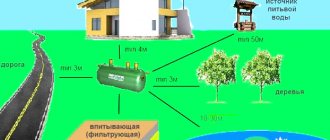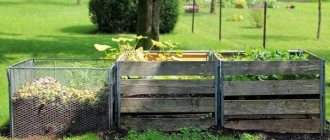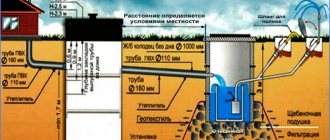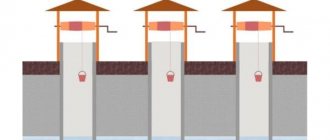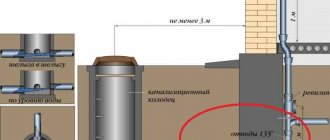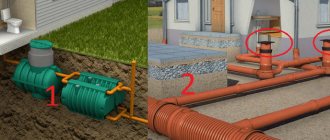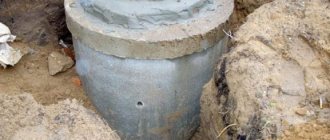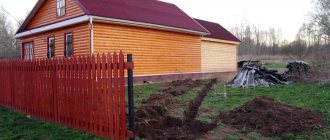Location of the sewerage system in relation to the foundation
Distance from underground networks to foundation
The distance from the sewer networks to the base of the building is indicated at the stage of creating the engineering lines project. Following the rules and regulations allows you to ensure safety for the residents of the house and the operation of all systems without breakdowns.
Minimum distance of various utility networks from the foundation of the house:
- pressure sewer – 500 cm;
- drainage – 300 cm;
- water supply – 500 cm;
- gravity sewerage – 300 cm;
- drainage line – 300 cm.
It is also necessary to take into account that wells for sewerage and water supply have a large diameter. The distance is taken from the base to the nearest well wall, and not to the center of the structure.
Sewage systems of private houses
In the development of suburban areas, autonomous sewage systems are often used, which are distinguished by the presence of a large number of positive qualities.
Some systems turn out to be more economically advantageous than using a central sewer, while others turn out to be the only possible solution to the sewage problem. For the normal functioning of external sewerage and ensuring quality service, the design of the system must be arranged in accordance with the rules and regulations reflected in regulatory documents.
The installation scheme of the sewer system and its operation largely depend on factors, which include:
- topographic indicators of the selected territory;
- types of soils located on the site;
- availability of water supply sources near the site;
- layout diagram of underground engineering networks that are already present on the territory.
The sewage system can be quite simple: the simplest design consists of a single section of pipeline that transports wastewater to a pit or septic tank located outside the building. You need to know at what distance from the house to install a septic tank. The simplest septic tank can be made from car tires stacked vertically on top of each other: the wastewater will still be filtered, and the solid fractions will be periodically pumped out by a sewer truck. This design is well suited for installation in suburban or small urban areas. For the sewer system to work normally, it is enough to provide a constant slope and periodically pump out.
It is much more difficult to install a sewer system in an area that has complex terrain or where there is a source of drinking water. In this case, the sewage system must comply with the sanitary requirements that apply to septic tanks or waste storage tanks. In addition, the design of the system can be complicated by connecting the drainage system and storm drainage to it.
Choosing a sewer installation location
In private homes, it is mandatory to install a purification device, whose task is to remove contaminated water. Separate sewerage means two trenches for the removal of wastewater: a storm water inlet and a domestic drain. Sewer pipes with a cross-section of less than 50 mm are buried 30 cm from the level where the soil reaches zero temperature. From 50 mm and more require a half-meter deepening below the depth of soil freezing.
The layout of pipelines and the location of wells for sewerage are thought out in advance. For rational placement of the septic tank, it is important to decide on the location of the water intake well, and also not to forget about all the distances recommended by SNiPs and sanitary standards. Sewage wells are capital structures for long-term operation. If initially installed in the wrong place, it is almost impossible to move them.
This approach to the construction of drainage systems allows us to reduce the risks of emergency situations, leaks and stagnation of wastewater. When planning, you need to consider:
- distance between nearby highways;
- remoteness from one's own and neighbors' buildings;
- distance to the street and highway;
- sewer pipe section;
- location of aquifers.
When placing a septic tank, be sure to take into account the prevailing wind direction during the year so that others do not suffer from an unpleasant odor.
To accurately determine the depth and location of underground communications, proceed in the following order:
- Draw up an accurate plan of all highways, taking into account the standards specified in SNiPs.
- Double-check that the design data matches the graphical diagrams or drawings.
- Before laying new communication lines, check whether there are old pipelines or sections of the electrical network at their location.
All these actions will help prevent problems with damage to the electrical cable if it is present at the pipe laying site, as well as not break existing lines in order to avoid emergency situations.
Other regulatory requirements
In addition to those described, there are other requirements for the installation of external sewage systems. For example, the distance from a house to a sewer well of any type and purpose (the first in the direction of flow) should be at least 3 and no more than 12 meters. We should not forget about the sanitary standards regulating the location of sewer wells and pipelines in relation to reservoirs, sources of drinking water, water supply systems for household and drinking purposes, fruit trees and gardening plantings.
Main sanitary zones on a personal plot
Relative location of underground communications
When planning a drainage system, as well as water supply, first of all, familiarize yourself with the requirements of SNiP regarding the minimum permissible distances between networks. The vertical distances between water supply and sewerage pipes are determined according to SP 18.13330.2011 clause 6.12. Horizontally - according to SP 42.13330.2011 clause 12.36. In this case, the distance in light is taken into account - that is, between the most convex parts of neighboring objects.
According to these documents, the minimum distance must be maintained:
- from the roadway to the water pipe – 2 m;
- between the base of the house and communications – 4 m;
- from water supply and sewerage mains to power lines - 1 m;
- between water supply and sewerage routes and communication wires, power cables - 0.5 m;
- from trees to water supply pipes - 2 m, to the sewer system - 1.5 m.
The water main is laid over the sewerage system. The distance between the water supply pipes and the sewer system must be at least 40 cm when the lines run parallel.
When crossing water supply networks and sewer lines, the first ones are laid 40 cm above the sewer system strictly at a right angle. This measure allows you to protect the water supply system from sewerage entering it.
Water pipes made of polymers are quite durable, but at intersections they will need additional protection. Special cases with a length of 5 to 10 m are suitable for these purposes.
If for some reason the water supply network is laid lower than the sewerage system, the drainage system is also provided with additional protection. The safety cover must be installed on the sewer pipe, taking into account a minimum vertical distance of 40 cm.
When installing new pipelines or repairing existing ones in places where there are already intersections of utility communication lines, a trench is dug using an excavator to a depth of no more than a meter to the upper main line.
The introduction of different hydraulic lines into the building requires maintaining a distance between them of at least 150 cm. Inside, the wiring is carried out depending on the location of the riser. The horizontal distance between the sewer riser and the drinking water supply inlets must be at least 150 cm - with an inlet pipeline diameter of up to 20 cm inclusive; 300 cm – with a cross section larger than 20 cm.
The project may involve a separate sewer discharge from the drain. Then two pipelines are laid. A similar option is performed when constructing large houses and cottages. The rules for the location of the storm drain are the same.
What should be the distance from well to well
To construct a well on the site, there is not enough space with an accessible level of the aquifer. The fact is that there are a number of other requirements for the location of the water supply source, and if they are not met, then the water will easily become unsuitable for food use.
Then we will consider these requirements, by fulfilling which you can avoid troubles associated with poor water quality.
What specific sources of pollution are there?
Sources of pollution include a number of objects:
- Cesspools and pits;
- Burial places for animals and people;
- Warehouses for pesticides and fertilizers;
- Industry enterprises;
- Sewage facilities
- Landfills, etc.
It follows from this that when choosing a location, you need to focus on the distance from the well to the toilet, and the distance from other objects of pollution in your own and neighboring areas. This is due to the fact that unwanted elements will get into the water, as a result it can cause damage to health.
Arrangement of security zones
In the area from the sewer to the water pipe, according to the standards, it is assumed that security zones will be installed to preserve the environment and human health. Such a zone covers the water intake point and the transportation system. It looks like a circle with a diameter of up to 100 m (depending on territorial capabilities). Organic debris and chemicals are not allowed to get into the water here.
The second security zone will be organized around sewer lines. Its parameters are determined based on the design of the sewerage system and the level of seismic activity at the location of the building. The average distance is 5 m on both sides of the sewer line.
The sanitary zones of the water intake and wastewater points should not intersect.
For each region and region, standard distances between communication systems have been developed, taking into account the characteristics of the area. These requirements must be followed when designing and installing water-bearing and drainage systems. If you do not take into account the clear distance between water supply and sewerage elements, there is a risk of contamination of drinking water, which can cause problems with human health and the environment.
Distances that must be maintained when drawing up a project
When designing sewer and water supply systems, it is necessary to think in advance about the distance between the water supply and sewerage systems, and take into account how far the elements of the structure are from the house.
There are special rules for this. The horizontal distances between the outer edges of the pipes must be as follows:
- A distance of 5 m is laid from the pressure sewer water pipes to the foundation.
- From the gravity sewer - 3 m.
- There should be at least 1.5 m from the plastic water supply channels to the sewerage system.
- The distance between water supply networks is 1.5 m.
- Between sewer networks - 0.4 m. When carrying out sewerage and water supply, the first step is to decide on the material for the pipes. Not only the quality of the systems being installed depends on this, but also the distance between the pipes, which must be included in the project.
Most often, pipes made of polyethylene and PVC are chosen - among modern materials, these are distinguished not only by their long service life, but also by their low thermal conductivity, as well as their resistance to adverse influences. They have almost no deposits on the inner surface.
It is necessary to take into account the standards that are established for the distances between sewer and water supply systems. The intervals should be as follows:
- From sewerage to plastic water pipes - 1.5 m.
- From a cast iron water supply with a pipe diameter exceeding 20 cm to the sewer system - 3 m.
- From a cast iron water supply with a pipe diameter below 20 cm - 1.5 m.
- There should be a distance of 5 m from the asbestos-cement and reinforced concrete water supply system to the sewerage system.
If the sewer pipes cannot be placed lower than the water supply, a protective casing is installed on the drain pipe. The minimum vertical distance from the water pipe must be no less than 0.4 m. The location is determined depending on the specific conditions.
The arrangement of communication systems is carried out in stages:
1. The pipes are cut into sections with the length specified in the project, which will need to be laid in places prepared for this.
2. Before making connections, the rubber seals located in the pipes are prepared. They are treated with silicone grease - this increases the tightness of the connection and reduces the risk of damage to the rubber.
3. The pipes are joined. To do this, the elements are inserted at one end into the sockets of the previous ones.
4. The pipes are connected to each other using a welding machine, special lubricant, and fittings. Polypropylene pipes are connected, heating the desired areas. To connect metal-plastic elements, fittings are needed.
5. If to carry out communications it was necessary to punch holes in structural elements, they should be sealed using building mixtures.
It is better to install metal-plastic pipes in such a way that they remain visible. Connections sometimes start to leak. And polypropylene channels can be hidden in the walls or under additional finishing.

